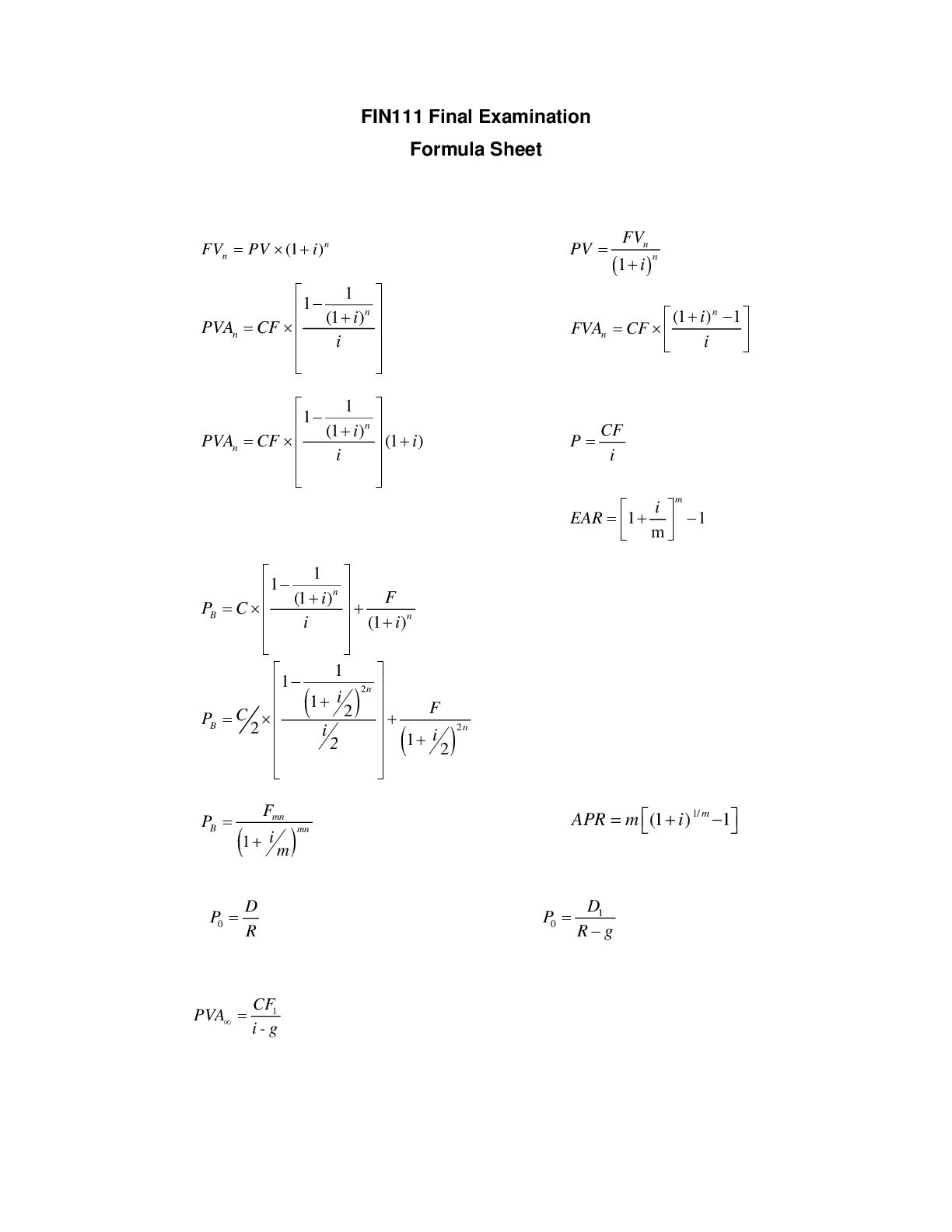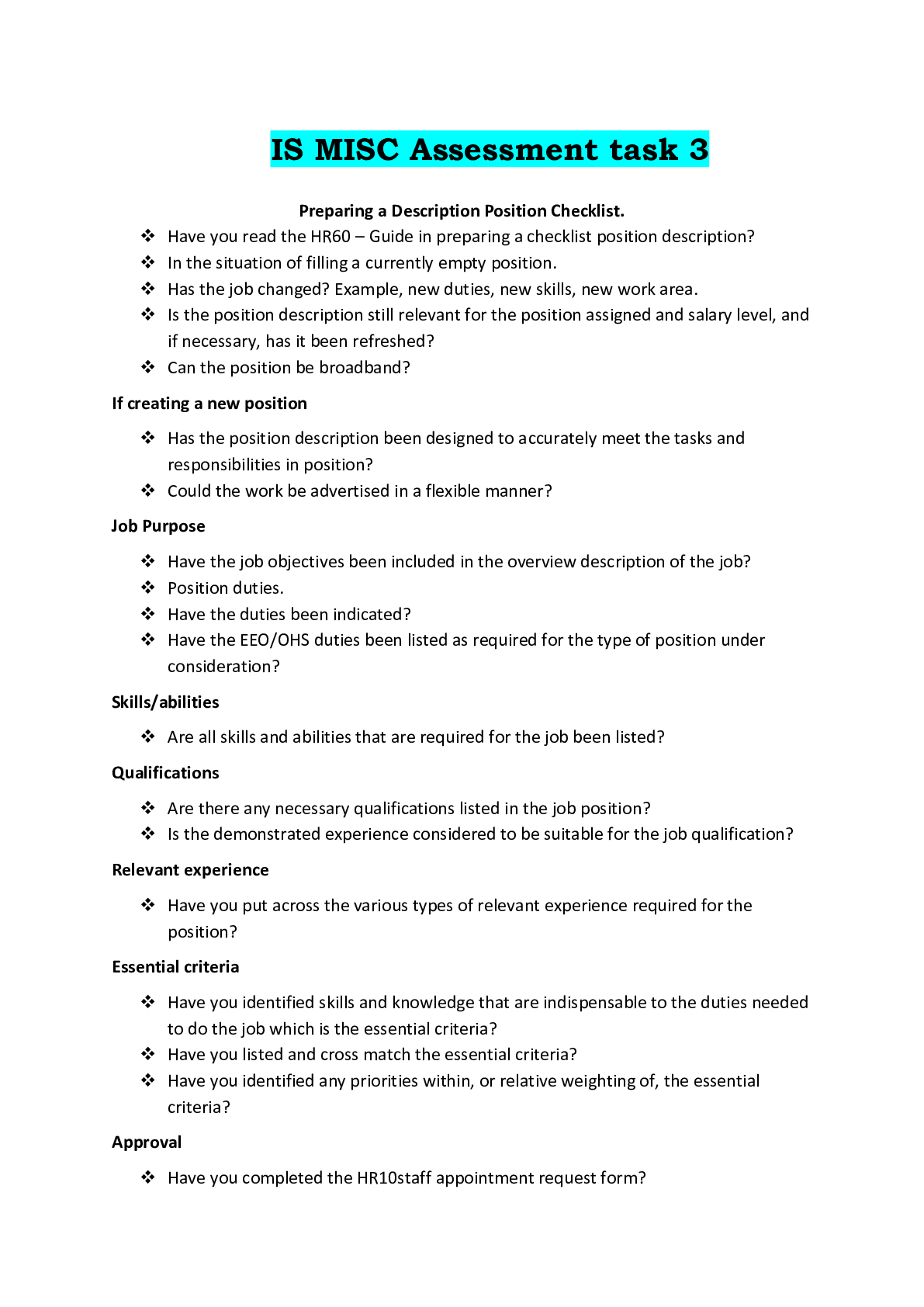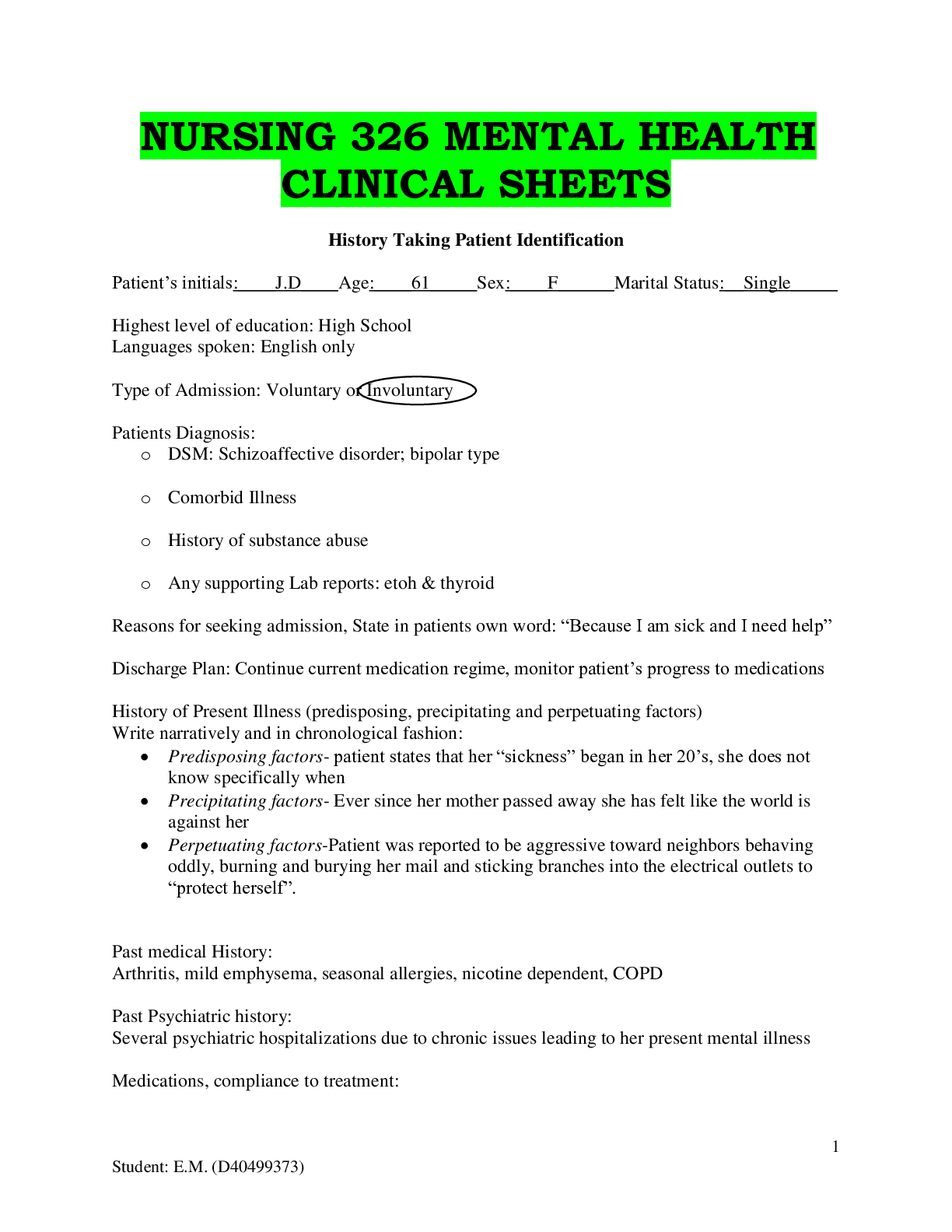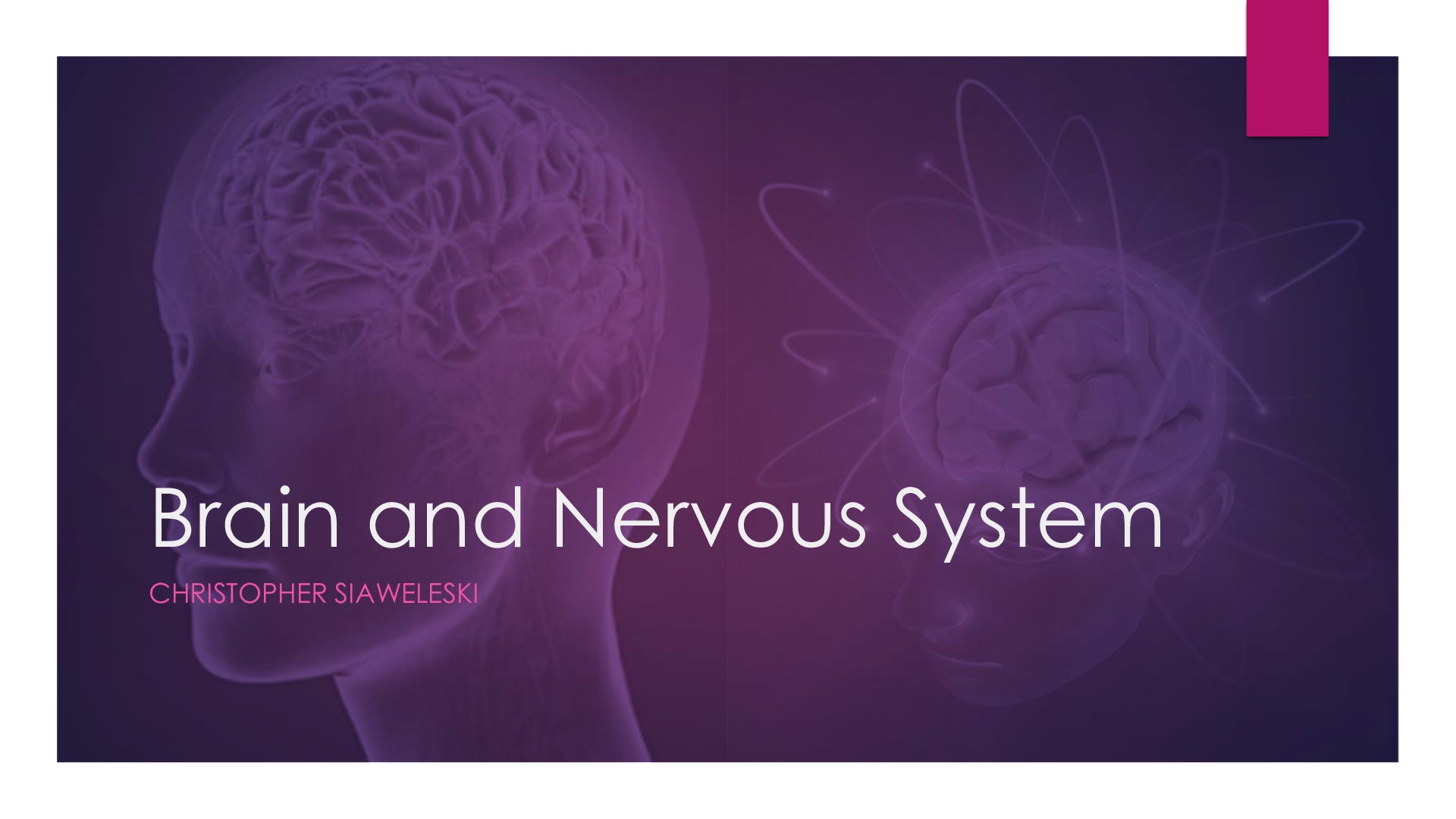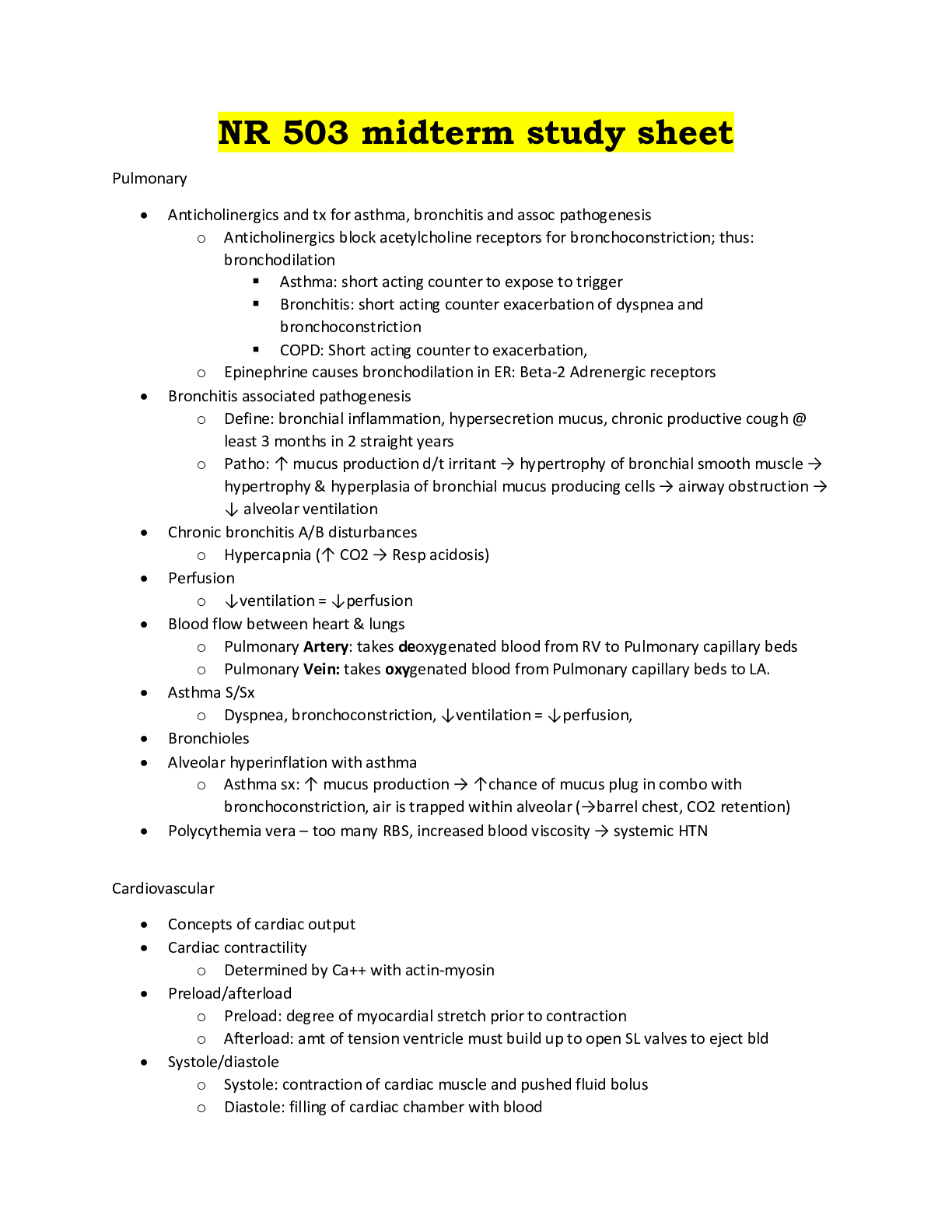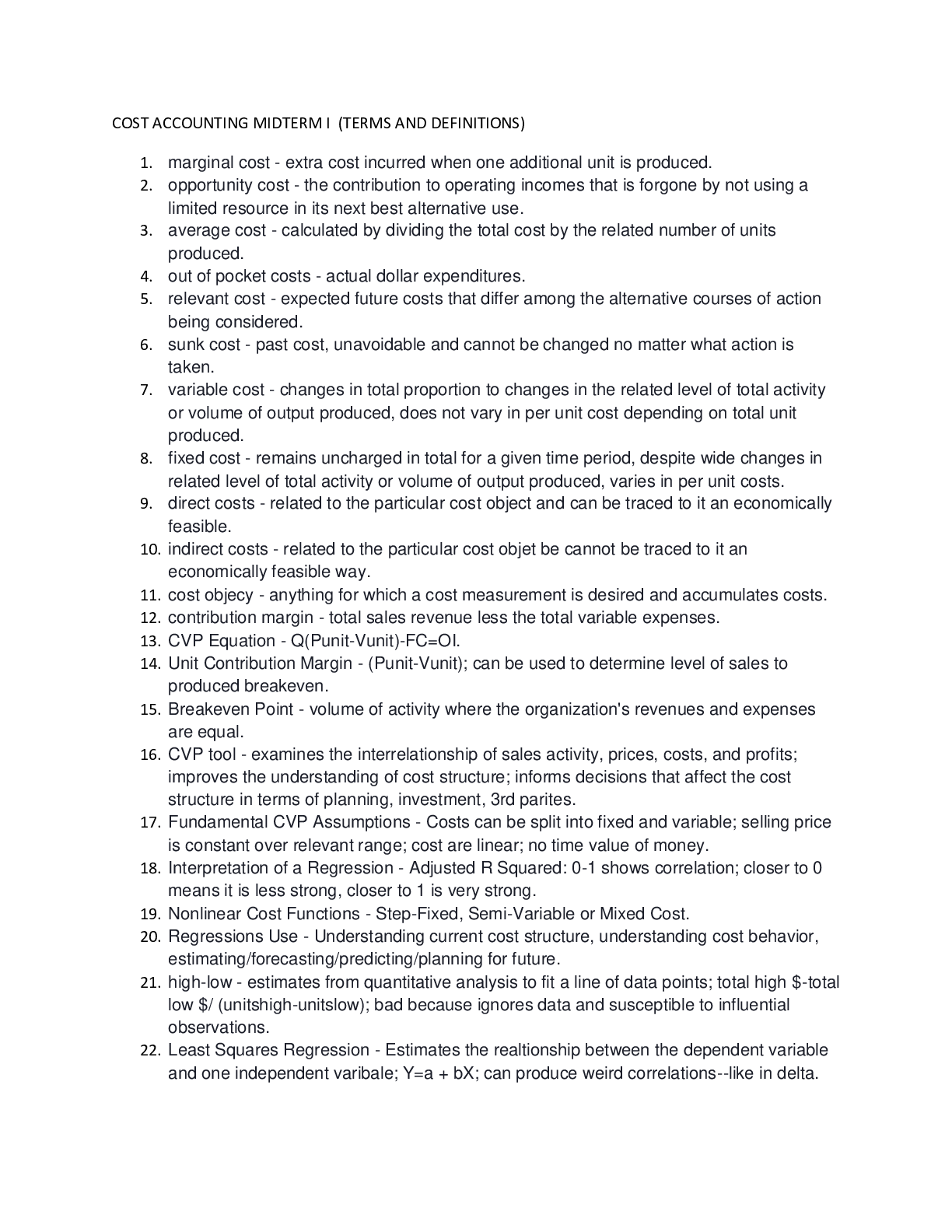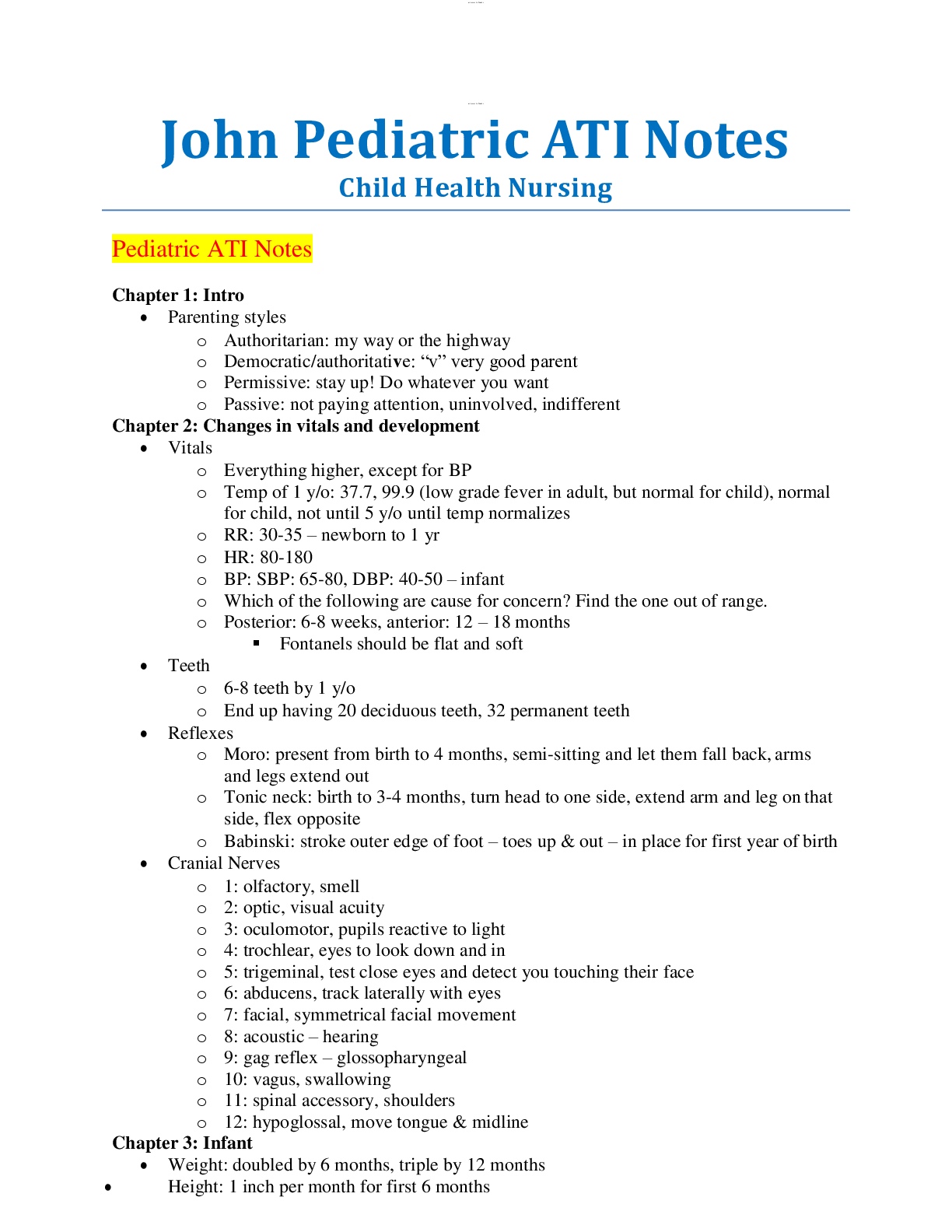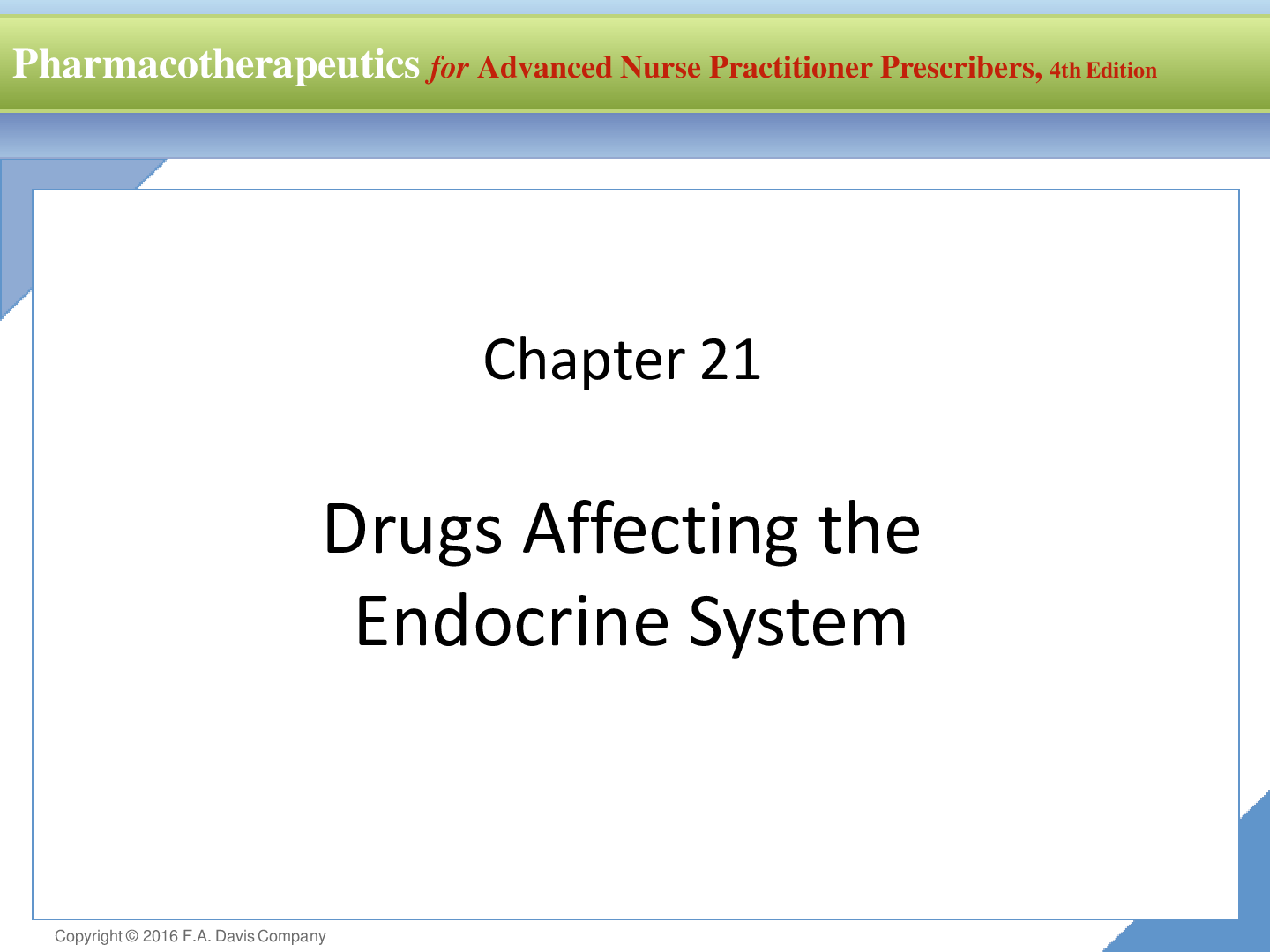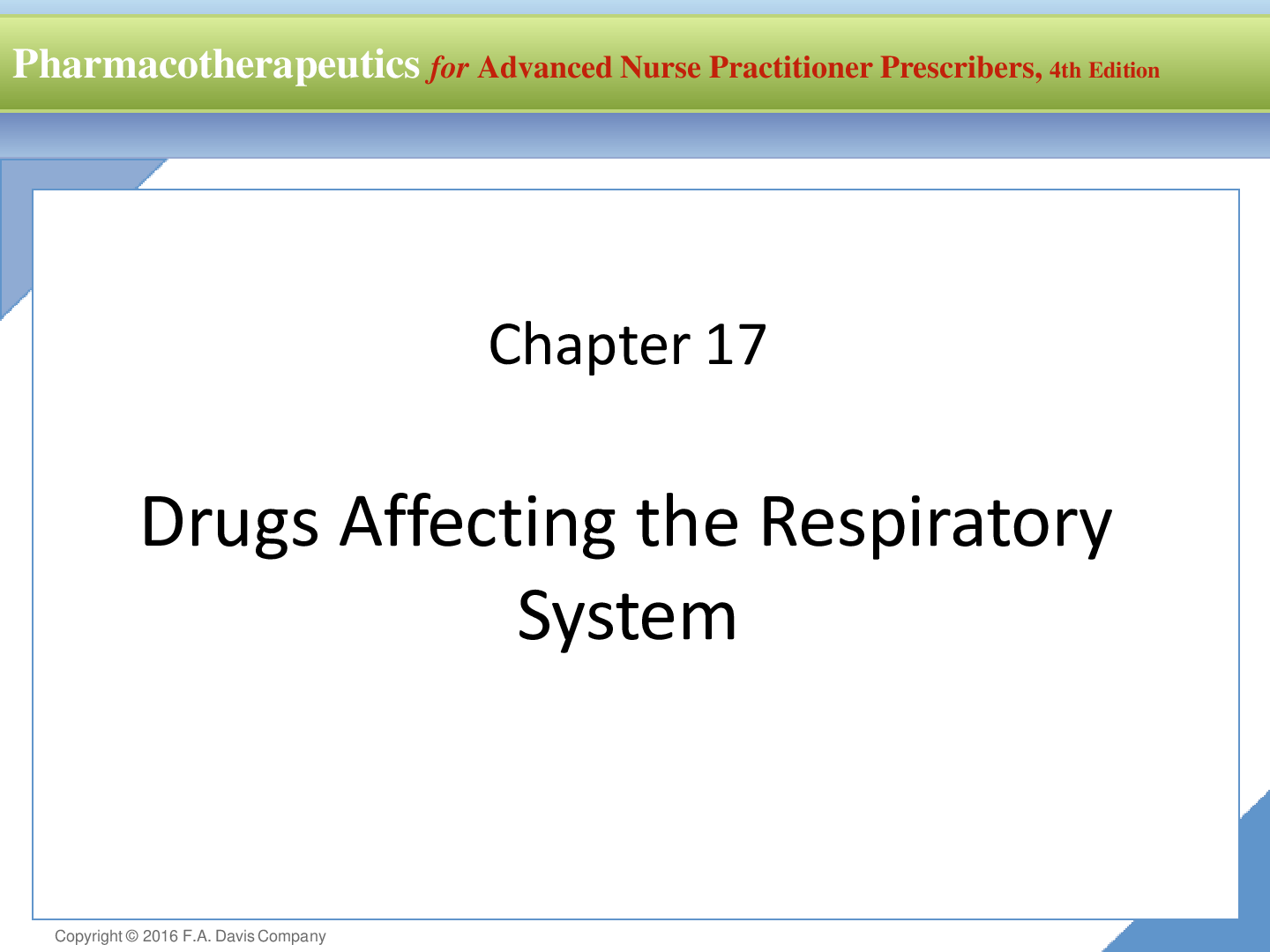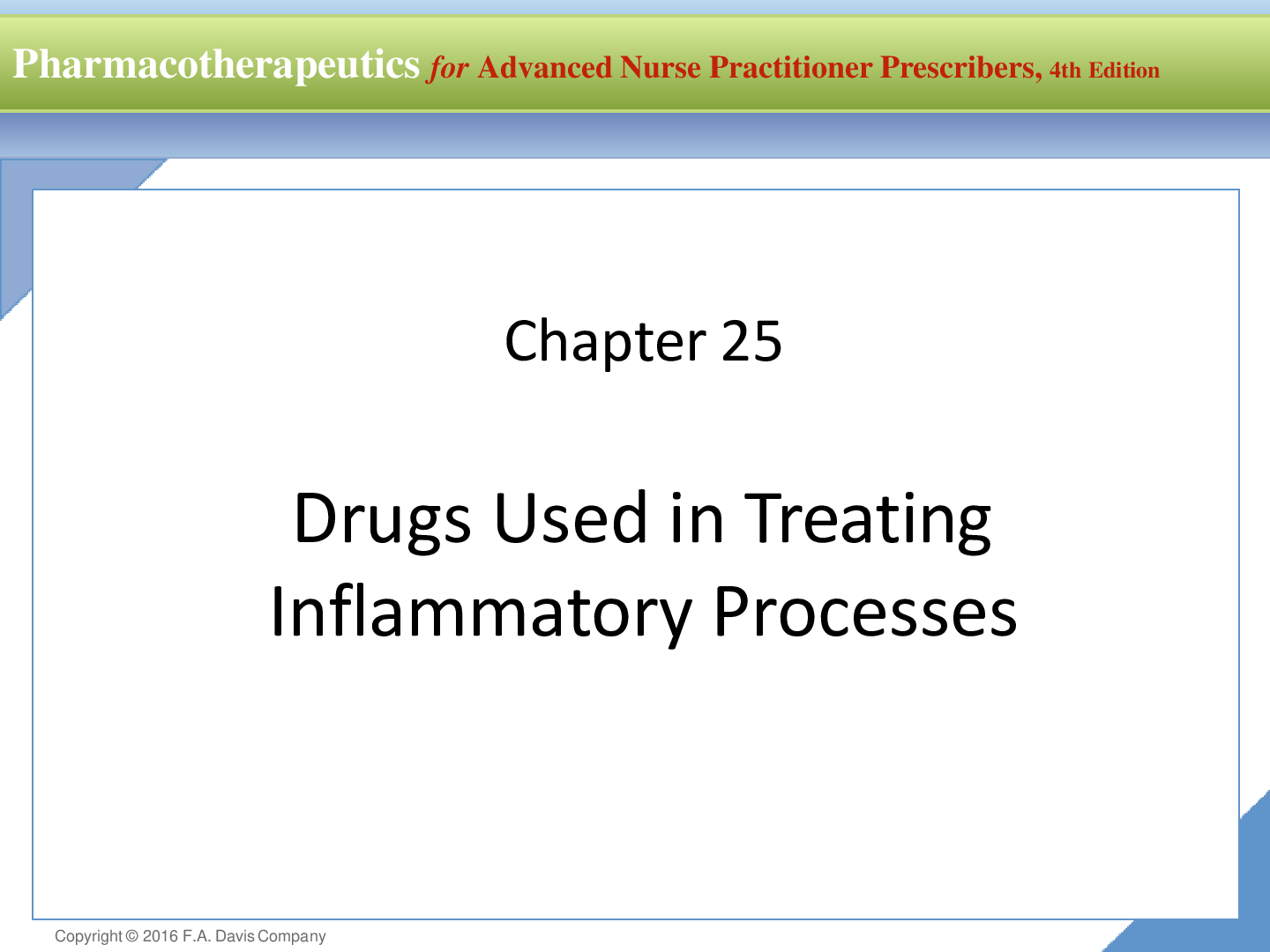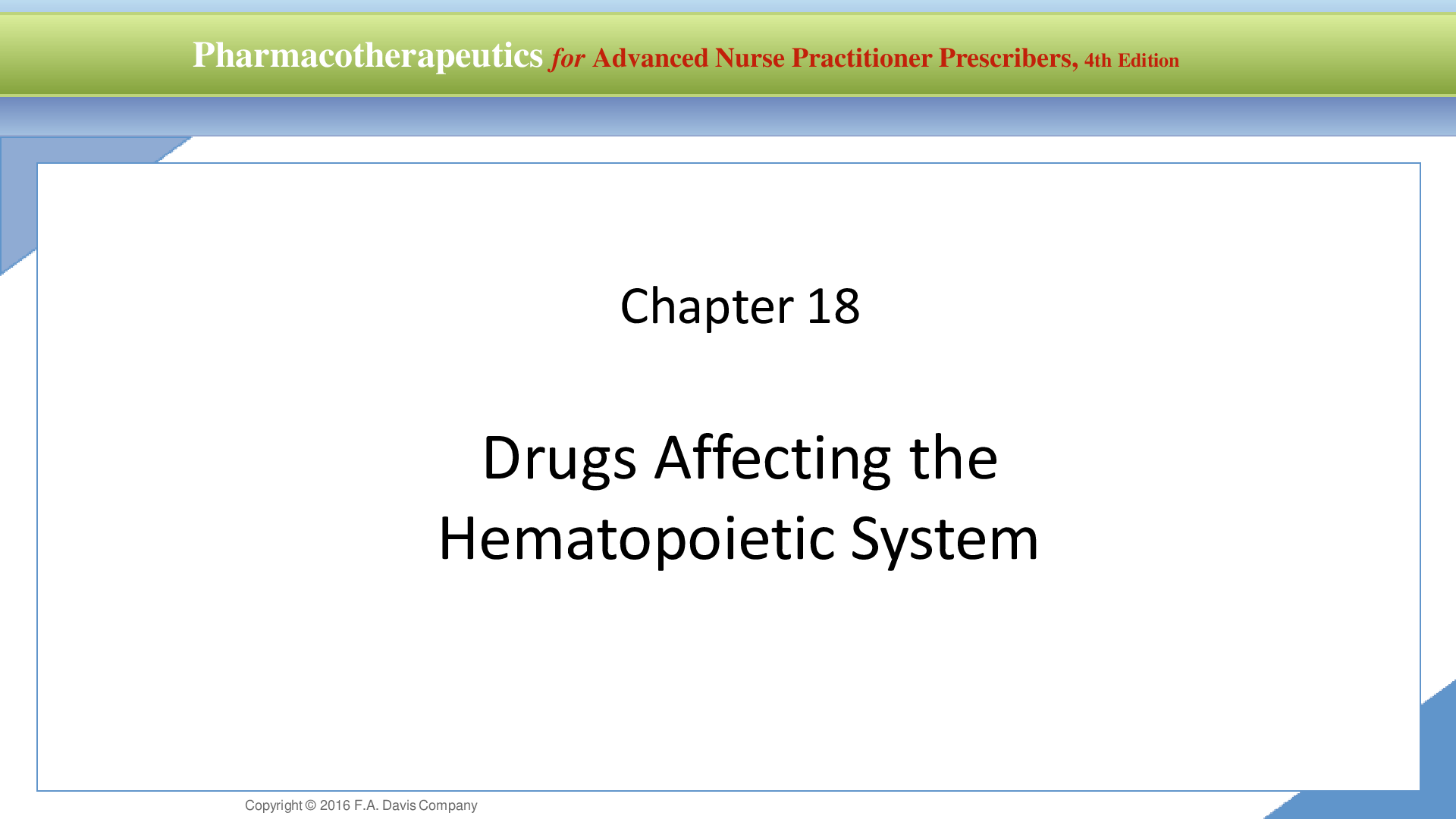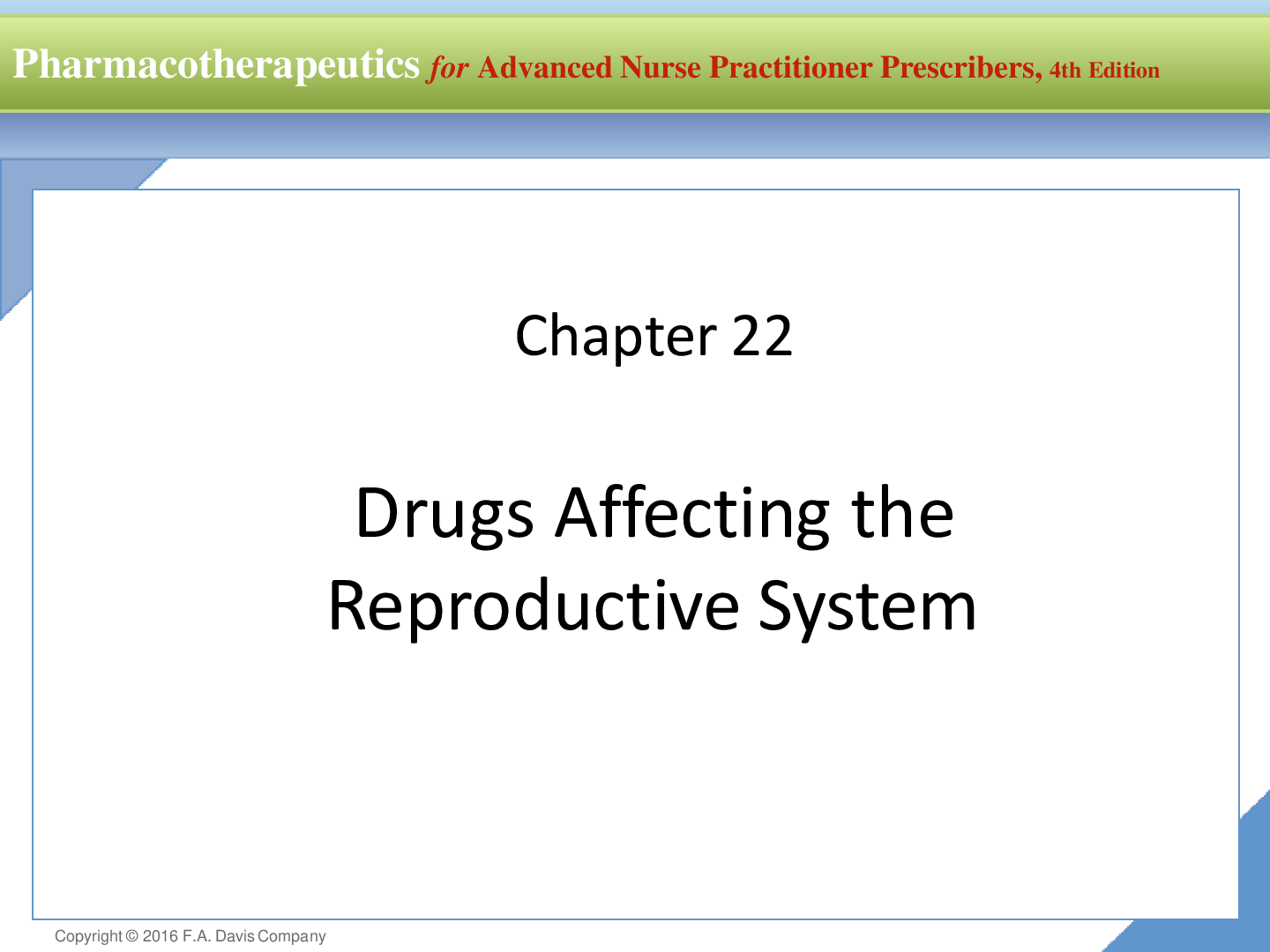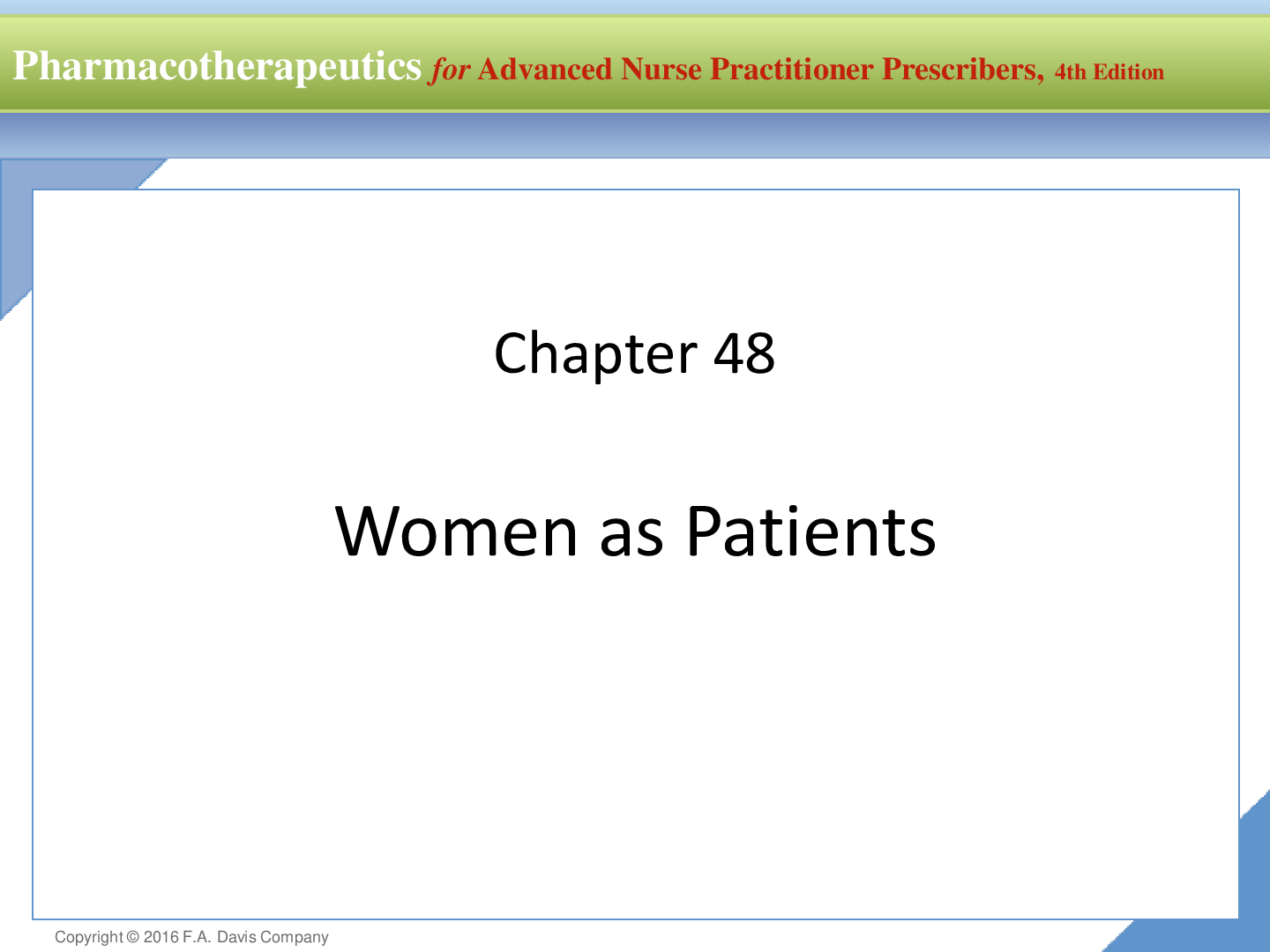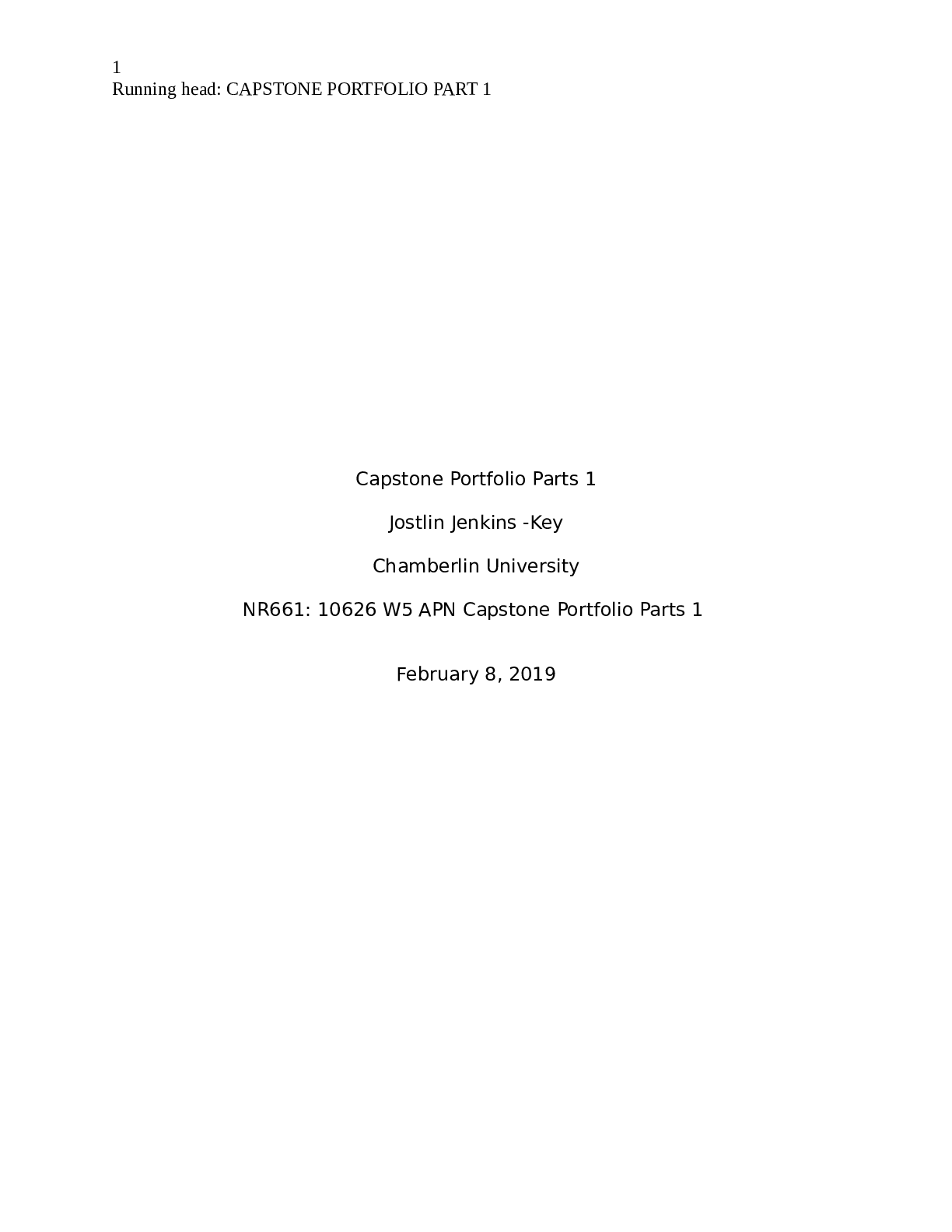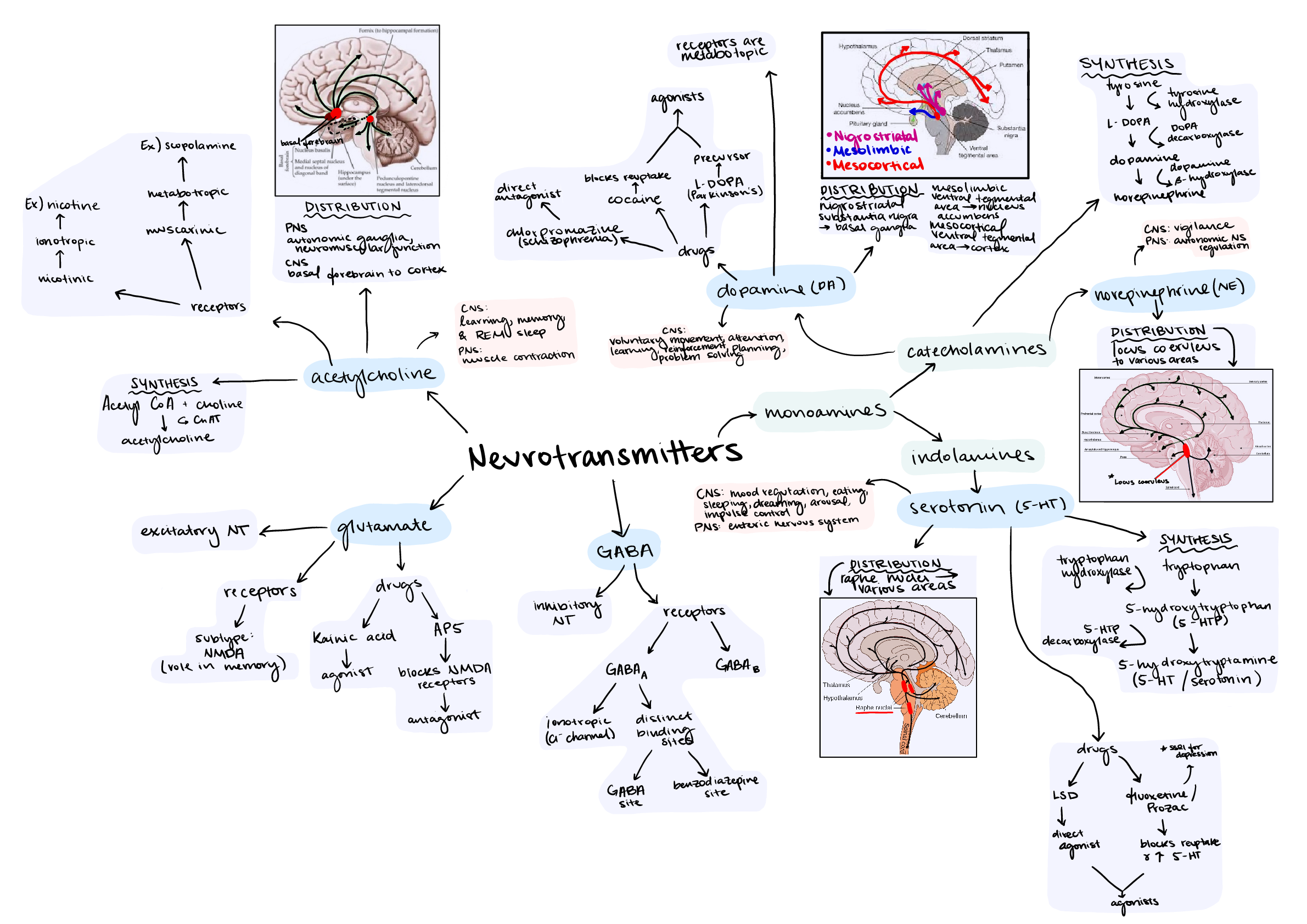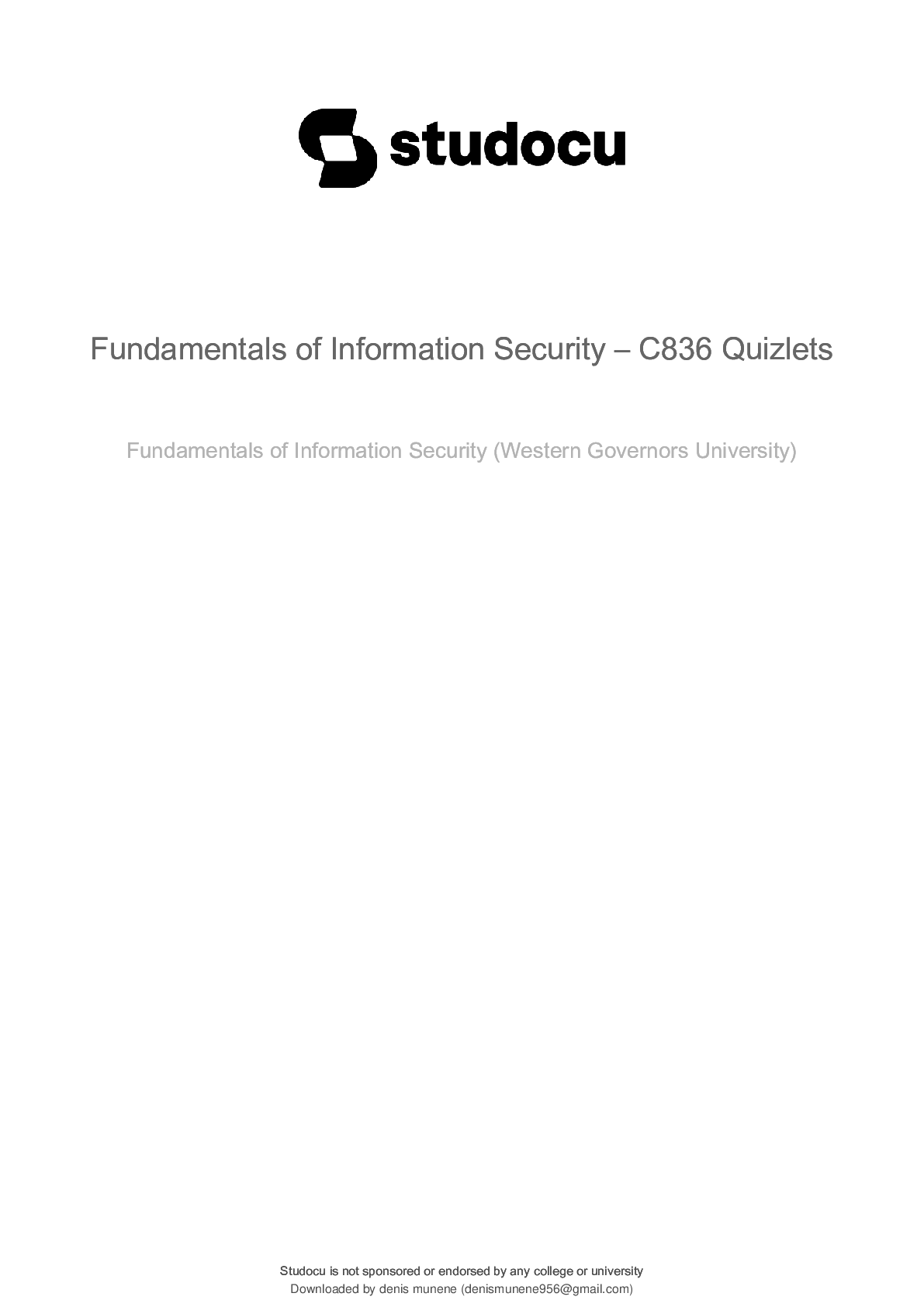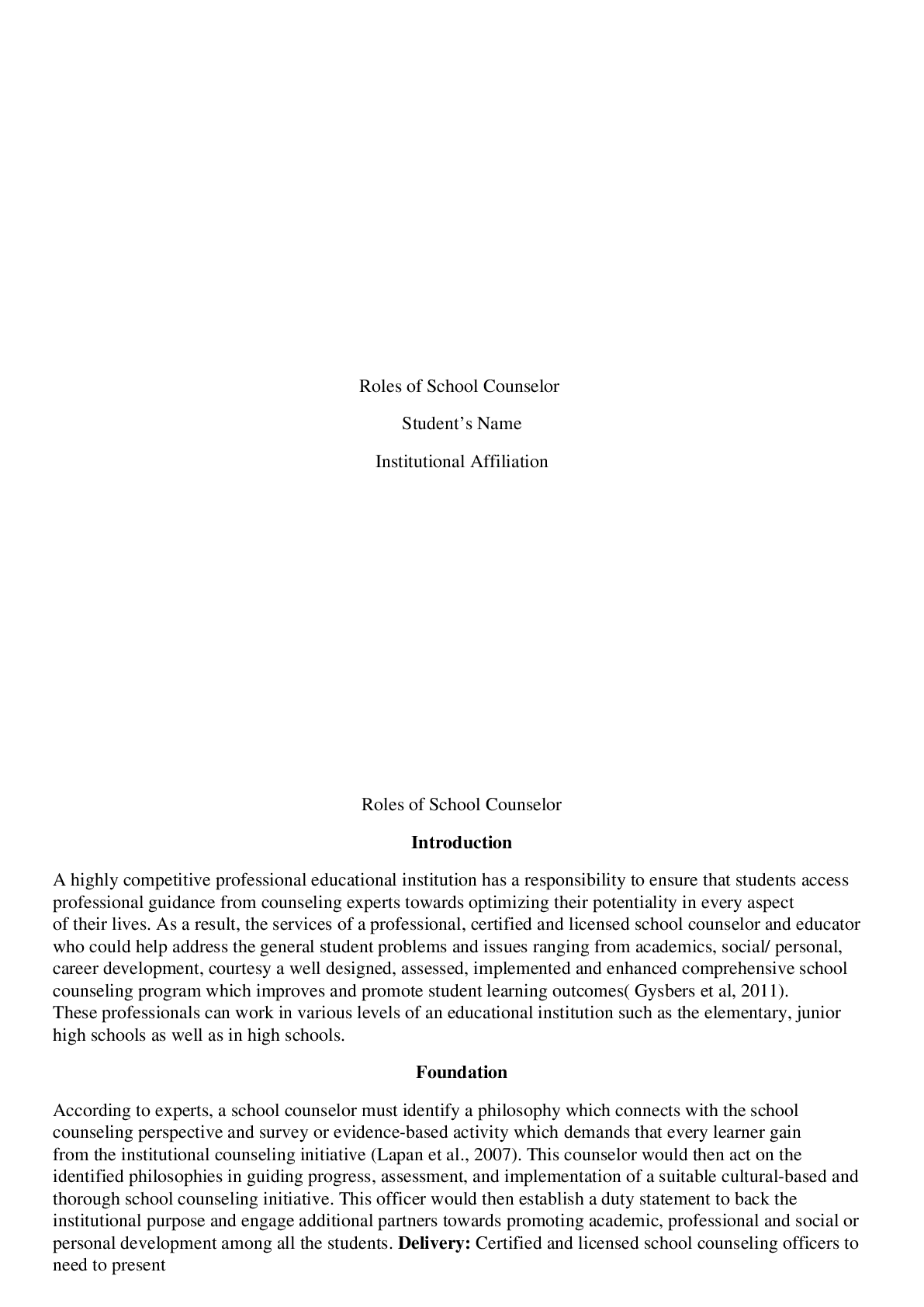Marketing > Class Notes > MKT 3210 Exam 4 Vocabulary (All)
MKT 3210 Exam 4 Vocabulary
Document Content and Description Below
MKT 3210 Exam 4 Vocabulary Chapter 11: Physical distribution – the activities that move finished goods from manufacturer to final customers, including order processing, warehousing, materials... handling, transportation, and inventory control Direct channel – a channel of distribution in which a manufacturer of a product or creator of a service distributes directly to the end customer Channel intermediaries – firms or individuals such as wholesalers, agents, brokers, or retailer who help move a product from the producer to the consumer or business user. And older term for intermediaries is middlemen Breaking bulk – dividing larger quantities of goods into smaller lots in order to meet the needs of buyers Create assortments – to provide a variety of production one location to meet the needs of buyers Transportation and storage – occurs when retailers and other channel members move the goods from the production point to other locations where they can hold them until consumers want them Facilitation functions – functions of channel intermediaries that make the purchase process easier for customers and manufacturers Risk-taking functions – the change retailers take on the loss of a product when they buy a product from a manufacturer because the product sits on the shelf because no customers want it Communication and transaction functions – happens when channel members develop and execute both promotional and other types of communication among members of the channel Disintermediation (of the channel distribution) – the elimination of some layers of the channel distribution to cut cost and improve the efficiency of the channel Knowledge management – a comprehensive approach to collecting, organizing, storing, and retrieving a firm’s information assets Intranet – an internal corporate communication network that uses Internet technology to link company departments, employees, and databases Online distribution piracy – the theft and unauthorized repurposing of intellectual property via the internet Wholesaling intermediaries – firms that handle the flow of products form the manufacturer to the retailer or business user Independent intermediaries – channel intermediaries that are not controlled by any manufacturer but instead do business with many different manufactures and many different customers Merchant wholesalers – intermediaries that buy goods from manufactures and sell to retailers and other B2B customers Take title – to accept legal ownership of a product and assume the accompanying rights and responsibilities of ownership Full-service merchant wholesalers – wholesales that provide a wide range of service for the customers, including delivery, credit, product-use assistance, repairs, advertising, and other promotional support Limited-service merchant wholesalers – wholesalers that provide fewer services for their customers Merchandise agents or brokers – channel intermediaries that provide service in exchange for commissions but never take title to the product Channel levels – the number of distinct categories of intermediaries that make up a channel of distribution Dual or multiple distribution systems – a system where producers, dealers, wholesalers, retailers, and customers participate in more than one type of channel Hybrid marketing system – a marketing system that uses a number of different channels and communication methods to serve a target market Subscription boxes – new business model for distribution that supplies surprises by sending out a box each month filled with items you never knew you wanted but you just have to have Slotting allowance – a fee paid in exchange for agreeing to place a manufacturer’s products on a retailer’s valuable shelf space Product diversion – the distribution of a product through one or more channels not authorized for use by the manufacturer or the product Diverter – an entity that facilitates the distribution of a product through one or more channels not authorized for use by the manufacturer of the product Distribution planning – the process of developing distribution objectives, evaluating internal and external environmental influences on distribution, and choosing a distribution strategy Distribution intensity – the number of intermediaries at each level of the channel Conventional marketing system – a multiple-level distribution channel in which channel members work independently of one another Vertical marketing system (VMS) – a channel of distribution in which there is formal cooperation among members at the manufacturing, wholesaling, and retailing levels Administered VMS – a vertical marketing system in which channel members remain independent but voluntarily work together because of the power of a single channel member Corporate VMS – a vertical marketing system in which a single firm owns manufacturing, wholesaling, and retailing operations Contractual VMS – a vertical marketing system in which cooperation is enforced by contracts that spell out each member’s rights and responsibilities and how they will cooperate Retailer cooperative – a group of retailers that establishes a wholesaling operation to help them compete more effectively with the large chains Franchise organizations – a contractual vertical marketing system that includes a franchiser who allows an entrepreneur to use the franchise name and marketing plan for a fee Horizontal marketing system – an agreement within a channel of distribution in which two or more firms at the same channel level work together for a common purpose Intensive distribution – selling a product through all suitable wholesalers or retailers that are willing to stock and sell the product Exclusive distribution – selling a product only through a single outlet in a particular region Gray market – a distribution channel in which a product’s sale to a customer may be technically legal, but is set at a minimum considered inappropriate by the manufacturer of the related product; often emerge around high-end luxury goods sold through exclusive distribution Selective distribution – distribution using fewer outlets than intensive distribution more than elective distribution Channel leader – the dominant firm that controls the channel Channel power – the ability of one channel member to influence, control, and lead the entire channel based on one or more sources of power Channel cooperation – occurs when producers, wholesalers, and retailers depend on one another for success Channel conflict – incompatible goals, poor communication, and disagreement over roles, responsibilities, and functions among firms at different levels of the same distribution channel that may threaten a manufacturer’s distribution strategy Logistics – the process of designing, managing, and improving the movement of products through the supply chain Reverse logistics – includes product returns, recycling and material reuse, and waste disposal Order processing – the series of activities that occurs between the time an order comes into the organization and the time a product goes out the door Enterprise resource planning (ERP) systems – a software system that integrates information from across the entire company, including finance, order fulfillment, manufacturing, and transportation, and then facilitates sharing of the data throughout the firm Warehousing – storing goods in anticipation of sale or transfer to another member of the channel of distribution Distribution center – a warehouse that stores goods for short periods of time and that produces other functions such as breaking bulk Materials handling – the moving of products into, within, and out of warehouses Transportation – the mode by which the products move among channel members Inventory control – activities to ensure that goods are always available to meet consumers’ deadlines Level loading – a manufacturing approach intended to balance the inventory holding capabilities and production capacity constraints of a manufacturer for a particular product through the implementation of a consistent production schedule, employed both during and beyond periods of peak demand Stock-outs – zero-inventory situations resulting in lost sales and customer dissatisfaction Just in time (JIT) – inventory management and purchasing processes that manufacturers and resellers use to reduce inventory to very low levels and ensure that deliveries from suppliers arrive only when needed Supply chain – all the activities necessary to turn raw materials into a good or service and put it in the hands of the consumer or business customer Inventory turnover – the number of times a firm’s inventory completely cycles through during a defined time frame Supply chain management – the management of flows among firms and the supply chain to maximize total profitability Insourcing – a practice in which a company contracts with a specialist firm to handle all or part of its supply chain operations Chapter 12 Retailing – the final step in the distribution channel in which organizations sell goods and services to consumers for their personal use Wheel-of-retailing hypothesis – a theory that explains how retail firms change, becoming more upscale as they go through their life cycle Experimental merchandising – tactic whose intent is to convert shopping from a passive activity into a more interactive one, but better engaging the customer Destination retailer – firm that consumers view as a distinctive enough to become loyal to it. Consumers go out of their way to shop there Omnichannel marketing – a retail strategy that provides a seamless shopping experience, whether the customer is shopping online from a desktop or mobile device, by telephone or in a brick and mortar store Point-of-sale system (POS) – retail computer system that collect sales data and are hooked directly into the store’s inventory-control system Perpetual inventory unit control system – retail computer system that keeps a running total on sales, returns, transfers to other stores, and so on Automatic reordering system – retail reordering system that is automatically activated when inventories reach a certain level Beacon marketing – a retail marketing strategy in which beacon devices are placed strategically throughout a store and emit a Bluetooth signal to communicate with shoppers as the browse through the store Digital wallets – the use of Bluetooth that connects with customer smartphones and allows customers to pay for items without cash or even swiping a credit card Experiential shoppers – shoppers who shop because it satisfies their experiential needs, that is, their desire for fun Retailtainment – the use of retail strategies that enhance the shopping experience and create excitement, impulse purchases, and an emotional connection with the brand Shrinkage – losses experienced by retailers as a result of shoplifting, employee theft, and damage to merchandise Organized retail crime (ORC) – retail shoplifting by organized gangs of thieves that get away with thousands of dollars in goods in a single day Retail borrowing – the consumer practice of purchasing a product with the intent to return the nondefective merchandise for a refund after it has fulfilled the purpose for which it was purchased Consumer profiling – the act of tailoring the level of customer service based on a customers’ perceived ability to pay Service retailer – organization that offers consumers services rather than merchandise Merchandise mix – the total set of all products offered for sale by a retailer, including all product lines sold to all consumer groups Combination stores – retailers that offer consumers food and general merchandise in the same store Supercenters – large combination stores that combine economy supermarkets with other lower-priced merchandise Merchandise assortment – the range of products a store sells Merchandise breadth – the number of different product lines available Merchandise depth – the variety of choices available for each specific product line Convenience stores – neighborhood retailers that carry a limited number of frequently purchased items and cater to consumers willing to pay a premium for the ease of buying close to home Supermarkets – food stores that carry a wide selection of edibles and related products Box stores – food stores that have limited selection of items, few brands per item, and few refrigerated items Specialty stores – retailers that carry only a few product lines but offer good selection within the lines that they sell Category killer – a very large specialty store that carries a vast selection of products in its category Leased departments – departments within a larger retail store that an outside firm rents Variety stores – stores that carry a variety of inexpensive items General merchandise discount stores – retailers that offer a broad assortment of items at low prices with minimal service Off-price retailers – retailers that buy excess merchandise from well-known manufacturers and pass the savings in to customers Warehouse clubs – discount retailers that charge a modest membership fee to consumers who buy a broad assortment of food and nonfood items in bulk and in a warehouse environment Factory outlet store – a discount retailer, owned by a manufacturer, that sells off defective merchandise and excess inventory Department stores – retailers that sell abroad range of items and offer a good selection within each product line Bifurcated retailing – with the decline of middle-of-the-market retailing, both mass merchandising and niche retailing dominate the retail market Hypermarkets – retailers with the characteristics of both warehouse stores and supermarkets; hypermarkets are several times larger than other store and offer virtually everything form grocery items to electronics Pop-up stores – retail stores, such as Halloween costume stores, that pop up one day then disappear after a period of one day to a few months Nonstore retailing – any method used to complete an exchange with a product end user that does not require a customer visit to the store B2C ecommerce – online exchanged between companies and individual customers M-commerce – promotion al other ecommerce activities transmitted over mobile phones and other mobile devices, such as smartphones and personal digital assistants Virtual experiential marketing – an online marketing strategy that uses enhancements, including colors, graphics, layout, and design, interactive videos, contests, games, and giveaways, to engage experiential shoppers online Shopping cart abandonment – occurs when ecommerce customers leave an ecommerce site with unpurchased items in their cart Direct selling – an interactive sales processing which a salesperson presents a product to one individual or a small group takes orders, and delivers the merchandise Green River Ordinances – community regulations that prohibit door-to-door selling unless prior permission is given by the household Party plan system – a sales technique that relies heavily on people getting caught up in the group spirit, buying things they wouldn’t normally buy if they were alone Multilevel or network marketing – a system in which a master distributor recruits other people to become distributors, sells the company’s product to the recruits, and receives a commission on all the merchandise sold by the people recruited Pyramid schemes – an illegal sales technique that promises consumers or investors large profits from recruiting others to join the program rather than from any real investment or sale of goods to the public Intangibles – experience-based products Services – intangible products that are exchanged directly between the producer and the customer Intangibility – the characteristic of a service that means customers can’t see, touch, or smell good service Perishability – the characteristic of a service that makes it impossible to store for later sale or consumption Capacity management – the process by which organizations adjust their offerings in an attempt to match demand Variability – the characteristic of a service that means that even the same service performed by the same individual for the same customer can vary Service encounter – the actual interaction between the customer and the service provider Disintermediation – the elimination of some layers of the channel of distribution to cut costs and improve the efficiency of the channel Servicescape – the actual physical facility where the service is performed, delivered, and consumed SERVQUAL – a multiple-item scale used to measure service quality across dimensions of tangibles, reliability, responsiveness, assurance, and empathy Gap analysis – a marketing research method that measures the difference between a customer’s expectation of a service quality and what actually occurred Place marketing – marketing activities that seek to attract new businesses, residents, or visitors to a town, state, country, or some other site Idea marketing – marketing activities that seek to gain market share for a concept, philosophy, belief, or issue by using elements of the marketing mix to create or change a target market’s attitude or behaviorChapter 13: Integrated marketing communication (IMC) – a strategic business process that marketers use to plan, develop, execute, and evaluate coordinated, measurable, persuasive brand communication programs over time to targeted audiences Multichannel promotion strategy – a marketing communication strategy where they combine traditional advertising sales promotion, and public relations activities with online buzz building activities Word of mouth communication – when consumers provide information about products to other consumers Communication model – the process whereby meaning is transferred from a source to a receiver Source – an organization or individual that sends a message Encoding – the process of translating an idea into a form of communication that will convey meaning Message – the communication in physical form that goes from a sender to a receiver Medium – a communication vehicle through which a message is transmitted to a target audience Receiver – the organization or individual that intercepts and interprets the message Decoding – the process by which a receiver assigns meaning to the message Noise – anything that interferes with effective communication Feedback – receivers’ reactions to the message Promotion mix – the communication elements that the marketers controls Mass communication – related to TV, radio, magazines, and newspapers Hierarchy of effects – a series of steps prospective consumers move through, from initial awareness of a product to brand loyalty Top-down budgeting techniques – allocation of the promotion budge based on management’s determination of the total amount to be devoted to marketing communication Percentage-of-sales method – a method for promotion budgeting that is based on a certain percentage of either last year’s sales or estimates of the present year’s sales Competitive-parity method – a promotion budgeting method in which an organization matches whatever competitors are spending Bottom-up budgeting techniques – allocation of the promotion budget based on identifying promotion goals and allocating enough money to accomplish them Objective-task method – a promotion budgeting method in which an organization first defines the specific communication goals it hopes to achieve and then tries to calculate what kind of promotion efforts it will take to meet their goals Push strategy – the company tries to move its products through the channel by convincing channel members to offer them Pull strategy – the company tried to move its products through the channel by building desire for the products among consumers, thus convincing retailers to respond to this demand by stocking these items Advertising – nonpersonal communication from an identified sponsor using the mass media TV Everywhere (authenticated streaming) – the use of an internet-enabled device, like a tablet or smartphone, to stream content from a cable or satellite provider Product advertising – advertising messages that focus on a specific good or service Institutional advertising – advertising messages that promote the activities, personality, or point of view of an organization or company Corporate advertising – advertising that promotes the company as a whole instead of a firm’s individual products Advocacy advertising – a type of public service advertising where an organization seeks to influence public opinion on an issue because it has some stake in the outcome Public service advertising (PSAs) – advertising run by the media for non-profit organizations or to champion a particular cause without change Retail and local advertising – advertising that informs consumers about store hours, location, and products that are available or on sale Advertising campaign – a coordinated, comprehensive plan that carries out promotion objectives and results in a series of advertisements placed in media over a period of time Limited-service agency – an agency that provides one or more specialized services such as media buying or creative development Full-service agency – an agency that provides most or all of the services needed to mount a campaign, including research, creation of ad copy and art, media selection, and production of the final messages Account executive – a member of the account management department who supervises the day-to-day activities of the account and is the primary liaison between the agency and client Account planner – a member of the account management department who combines research and account strategy to act as the voice of the consumer in creating effective advertising Creative services – the agency people who dream up and produce the ads Research and marketing services – the advertising agency department that collects and analyzes information that will help account executives develop a sensible strategy and assist creatives in getting consumer reactions to different versions of ads Media planners – agency personnel who determine which communication vehicles are the most effective and efficient to deliver the ad Do-it-yourself ads (DIY ads) – product ads that are created by consumers Corrective advertising – advertising that clarifies or quantifies previous deceptive advertising campaigns Puffery – claims made in advertising of product superiority that cannot be proven true or untrue Greenwashing – a practice in which companies promote their products as environmentally friendly when in truth the brand provides little ecological benefit Creative strategy – the process that turns a concept into an advertisement Creative brief – a guidelines or blueprint for the marketing communication program that guides the creative process Advertising appeal – the central idea or theme of an advertising message Unique selling proposition (USP) – an advertising appeal that focuses on one clear reason why a particular product is superior Reminder advertising – advertising aimed at keeping the name of a brand in people’s minds to be sure consumers purchase the product as necessary Teaser ad or mystery ad – ads that generate curiosity and interest in a to-be-introduced product by drawing attention to an upcoming ad campaign without mentioning the product Execution format – the basic structure of the message, such as comparison, demonstration, testimonial, slice of life, and lifestyle Comparative advertising – advertising that compares one brand with a second named brand Slice of life advertising – presents a dramatized scene from everyday life Lifestyle advertising – show a person(s) attractive to the target market inn appealing setting with the advertised product as part of the scene, implying that the person who buys it will attain the lifestyle Tonality – the mood or attitude the message conveys Fear appeals – advertisements that highlight the negative consequences of not using a product by either focusing on physical harm or social disapproval Jingles – original words and music written specifically for advertising executions Slogans – simple, memorable linguistic device linked to a brand Pretesting – a research method that seeks to minimize mistakes by getting consumer reactions to ad messages before they appear in the media Media planning – the process of developing media objectives, strategies, and tactics for use in an advertising campaign Posttesting – research conducted on consumers’ responses to actual advertising messages they have seen or heard Unaided recall – a research technique conducted by telephone survey or personal interview that asks whether a person remembers seeing an ad during a specified period without giving the person the name of the brand Aided recall – a research technique that uses clues to prompt answers from people about advertisements they might have seen Attitudinal measures – a research technique that probes a consumer’s beliefs or feelings about a product before and after being exposed to messages about it Branded entertainment – a form of advertising in which marketers integrate products into entertainment venues Advergaming – brand placements in video games Native advertising – an execution strategy that mimics the content of the website where the message appears Support media – media such as directories or out-of-home media that may be used to reach people who are not reached by mass-media advertising Out-of-home media – communication media that reach people in public places Digital signage – out-of-home media that use digital technology to change the message at will Place-based media – advertising media that transmit messages in public places where certain types of people congregate Digital media – media that are digital rather than analog, including websites, mobile or cellular phones, and digital video Owned media – internet sites that are owned by an advertiser Paid media – internet media that are paid for by an advertiser Earned media – word-of-mouth or buzz using social media where the advertiser has no control Banners – internet advertising in the form of rectangular graphics at the top or bottom of webpages Buttons – small banner-type advertisements that can be placed anywhere on a webpage Pop-up ad – an advertisement that appears on the screen while a web page load or after it has loaded Spam – the use of electronic media to send unsolicited messages in bulk Permission marketing – email advertising in which online consumers have the opportunity to accept or refuse the unsolicited email Search engines – internet programs that search for documents with specified key words Search marketing – marketing strategies that involve the use of internet search engines Ad fraud – the use of automated browsers to falsify the number or views or clickthrough that the advertisers must pay for Ad blocking – the use of powerful ad-blocking software created to stop ad fraud by stripping ads from the website at the network level Mobile hijacking – the use of automated browsers to falsify the number of views or click-throughs the advertiser must pay for Search engine marketing (SEM) – search marketing strategy in which marketers pay for ads or better positioning Sponsored search ads – paid ads that appear at the top or beside the internet search engine results Mobile advertising – a form of advertising that is communicated to the consumer via a handset Text message advertising – delivering ads to consumers as mobile phone text messages Monetize – the act of turning an asset into money In-app advertising – to monetize free mobile phone apps, developers use advertising to create revenue and to engage the consumer QR code advertising – uses smartphone GPS technology to deliver ads and other information to consumers in stores and in other locations Video sharing – uploading video recordings on to internet sites so that thousands or even millions of other internet users can see them Vlogs – video recording shared on the internet Media schedule – the plan that specifies the exact media to use and when to use it Reach – the percentage of the target market that will be exposed to the media vehicle Frequency – the average number of times a person in the target group will be exposed to the message Gross rating points (GRPs) – a measure used for comparing the effectiveness of different media vehicles; average reach x frequency Cost per thousand (CPM) – a measure used to compare the relative cost effectiveness of different media vehicles that have different exposure rates Sales promotion – programs designed to build interest in or encourage purchase of a product during a specified period Rebates – sales promotions that allow the customer to recover part of the product’s cost from the manufacturer Frequency programs – consumer sales promotion programs that offer a discount or free product for multiple purchases over time Premiums – items offered free to people who have purchased a product Product sampling – distributing free trial-size versions of a product to consumers Trade sales promotions – promotions that focus on members of the trade Merchandising allowance – reimburses the retailer for in-store support of the product Case allowance – a discount to the retailer or wholesalers based on the volume of product ordered Co-op advertising – a sales promotion where the manufacturer and the retailer share the cost Trade shows – events at which many companies set up elaborate exhibits to show their products, give away samples, distribute product literature, and troll for new business contacts Promotional products – goodies such as mugs, t-shirts, and magnets given away to build awareness for a sponsor Point or purchase (POP) displays – in-store displays and signs Push money – a bonus paid by a manufacturer to a sales person, customer, or distributor for selling its product Chapter 14: Groundswell – a social trend in which people use technology to get the things they need from each other rather than from traditional institutions like corporations Social media – internet-based platforms that allow users to create their own content and share it with others who access these sites Social networks – online platforms that allow a user to represent himself or herself via a profile on a website and provide and receive links to other members of the network to share input about common interests Brand community – a group of social network users who share an attachment to a product or brand, interact with each other and share information about the brand Twitter – a free microblogging service that lets users post short text message with a maximum of 140 characters Virtual worlds – online, highly engaging digital environments where avatars live and interact with other avatars in real time Avatars – graphic representations of users of virtual worlds Virtual goods – digital products consumers buy for use in online contexts Product review sites – social media sites that enable people to post stories about their experience with goods and services Location-based social networks – networks that integrate sophisticated GPS technology that enables users to alert friends of their exact whereabouts via their mobile phones Augmented reality (AR) – a view of a physical, real worlds that is enhanced or altered by computer-generated sounds, videos, graphic, or GPS data Direct marketing – any direct communication to a consumer or business recipient designed to generate response in the form of an order, a request for further information, or a visit to a store or other place of business for purchase of a product Catalog – a collection of products offered for sale in book form, usually consisting of product descriptions accompanied by photos of items Direct mail – a brochure or pamphlet that offers a specific good or service at one point in time Telemarketing – the use of the telephone to sell directly to consumers and business customers Direct-response advertising – a direct marketing approach that allows the consumer to respond to a message by immediately contacting the provider to ask questions or order the product Direct-response TV (DRTV) – advertising on TV that seeks a direct response, including short commercials of less than two minutes, 30-minute or longer infomercials, and home shopping networks Infomercials – half-hour or hour-long commercials that resemble a talk show but actually are sales pitches M-commerce – promotional and other e-commerce activities transmitted over mobile phones and other mobile devices, such as smartphones and personal digital assistants Personal selling – marketing communication by which a company representative interacts directly with a customer or prospective customer to communicate about a good or service Partner relationship management (PRM) – similar to a CRM, the PRM system allows both selling and buying firms to share some of their information Voice-over internet protocol (VoIP) – communication systems that use data networks to carry voice calls Telecommute – working with fellow employees from a distant location using internet communication technology such as VoIP Virtual office – the use of internet technology to work and participate from a distant physical office Order taker – a salesperson whose primary function is to facilitate transactions that the customer initiates Technical specialist – a sales support person with a high level of technical expertise who assists in product demonstrations Missionary salesperson – a salesperson who promotes the firm and tries to simulate demand for a product but does not actually complete a sale New-business salesperson – the person responsible for finding new customers and calling on them to present the company’s products Order getter – a salesperson who works to develop long-term relationships with particular customers or to generate new sales Team selling – the sales function when handled by a team that may consist of a salesperson, a technical specialist, and others Key account – a very large customer organization with the potential for providing significant sales revenue Cross-functional team – a form on selling team where the team includes individuals from various areas of the firm Multilevel selling – a form of team selling in which the team consists of company personnel from various managerial levels, each calling on their counterpart in the customer organization Transactional selling – a form of personal selling that focuses on making an immediate sale with little or no attempt to develop a relationship with the customer Relationship selling – s form of personal selling that involves securing, developing, and maintaining long-term relationships with profitable customers Creative selling process – the process of seeking out potential customers, analyzing needs, determining how product attributes might provide benefits for the customer, and then communicating that information Prospecting – a part of the selling process that includes identifying and developing a list of potential or prospective customers Preapproach – a part of the selling process that includes developing information about prospective customers and planning the sales interview Approach – the first step of the actual presentation in which the sales person tries to learn more about the customer’s needs, create a good impression, and built rapport Sales presentation – the part of the selling process in which the salesperson directly communicates the value proposition to the customer and invites two-way communication Close – the stage of the selling process in which the salesperson actually asks the customer to buy the product Follow-up – activities after the sale that provide important services to customers Input measures – efforts that go into selling, such as the number and type of sales calls, expense account management, and a variety of non-selling activities, such as customer follow-up work Output measures – the results of the salesperson’s efforts Public relations (PR) – communication function that seeks to build good relationships with an organization’s publics, including consumers, stockholders, and legislators Publicity – unpaid communication about an organization that appears in the mass media Crisis management – the process of managing a company’s reputation when some negative event threatens the organization’s image Public relations campaign – a coordinated to communicate with one or more of the firm’s publics Press release – information that an organization distributes to media intended to win publicity Video news release (VNR) – similar to a press release, an organization sends a report to the media in a firm format Internal PR – PR activities aimed at employees of an organization Investor relations – PR activities such as annual and quarterly reports aimed at a firm’s investors Lobbying – talking with and providing information to government officials to influence their activities relating to an organization Speech writing – writing a speech on a topic for a company executive to deliver Corporate identity – materials such as logos, brochures, building design, and stationary that communicate an image of the organization Media relations – a PR activity aimed at developing close relationships with the media Sponsorships – PR activities through which companies provide financial support to help find an event in return for publicized recognition of the company’s contribution Special events – activities that are planned and implemented by a PR department Brand ambassadors – loyal customers of a brand recruited to communicate and be salespeople with other consumers for a brand they care a great deal about Guerrilla marketing – marketing activity in which a firm ambushes consumers with promotional content in places they are not expecting to encounter this kind of activity Ambient advertising – advertising placed where advertising isn’t normally or hasn’t ever been seen Buzz – word-of-mouth communication that customers view s authentic Buzz marketing – marketing activities designed to create a conversation, excitement, and enthusiasm, about a brand Tryvertising – advertising by sampling that is designed to create buzz about a product F-commerce – e-commerce that takes place on Facebook Brand polarization – the gap between good buzz and bad buzz Viral marketing – marketing activities that aim to increase brand awareness or sales by consumers passing a message along to other consumers Sock puppeting – a practice where a company executive or other biased source poses as someone else to plug a product in social media Paid influencer programs – another form of sock puppeting in which bloggers are paid or rewarded in some way for attempting to start online conversations about a brand [Show More]
Last updated: 1 year ago
Preview 1 out of 14 pages

Reviews( 0 )
Document information
Connected school, study & course
About the document
Uploaded On
May 16, 2021
Number of pages
14
Written in
Additional information
This document has been written for:
Uploaded
May 16, 2021
Downloads
0
Views
71

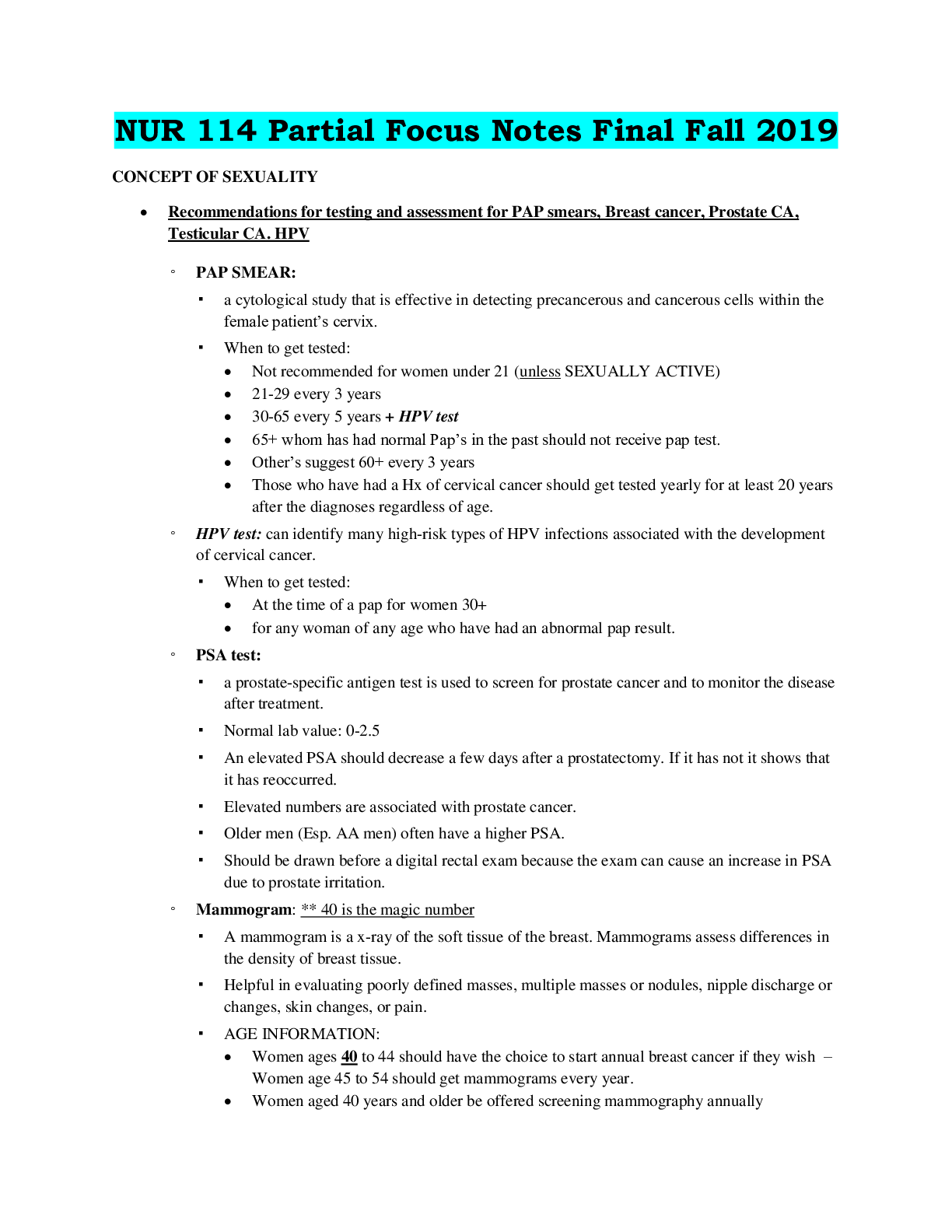
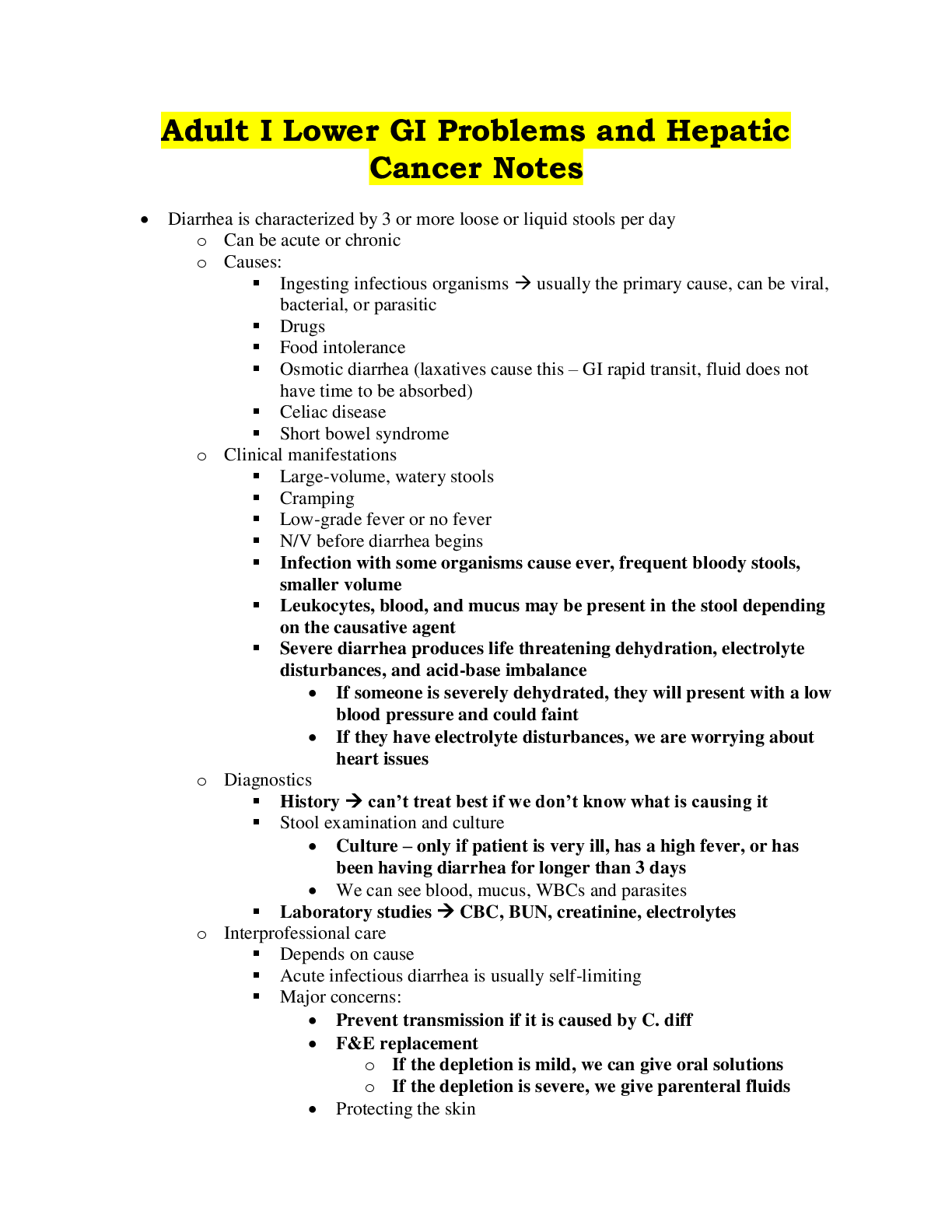

.png)
